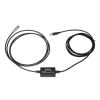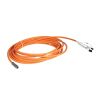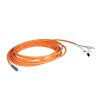Solinst Water Level Temperature Sensors
Features
- Vented or absolute pressure sensor options with 0.05% full scale accuracy
- SDI-12, RS-485 Modbus RTU, and 4-20mA protocols for interfacing with data loggers and PLC systems
- Built-in hydrophobic filters eliminate the need for desiccant replacement on vented sensors
- Free ground shipping
- Expedited repair and warranty service
- Lifetime technical support
- More
Overview
The Solinst Water Level Temperature Sensor is a compact, all-in-one submersible hydrostatic level transmitter that provides continuous, stable and accurate water level and temperature readings for a wide variety of applications. The water level pressure sensor and temperature sensor are enclosed in a slim, robust 22 mm x 192 mm (7/8" x 7.55") 316L stainless steel housing. Double O-ring seals prevent leaks, and a Faraday cage design protects against power surges and lightning.
Design
Each probe features a removable nose cone for optional use of the 1/4" NPTM threaded connection. The durable water level pressure sensor provides 0.05% FS accuracy with automatic temperature-compensated readings. There are six pressure ranges to choose from (5-200 m), with options for absolute (non-vented) and gauged (vented) pressure sensor setups.
Data Availability
The Water Level Temperature Sensor works with digital and analog protocols – MODBUS, SDI-12, and 4-20mA (add-on Current Loop Adaptor). They are easy to integrate into existing SCADA or PLC systems. Communication cable assemblies are available in lengths up to 300 meters. The cables are easily and securely attached to the sensor using a threaded connection. Simple PC software utilities are used to set up the sensor for the different protocols, perform simple diagnostics, and update sensor firmware if required. A USB-A programming cable is available for connection to the PC.
In The News
Solinst Model 301 WLTS: Works Well Under Pressure
From an already successful line of water level and temperature loggers comes the new Water Level Temperature Sensor (WLTS) by Solinst, Inc. Unlike other water level measurement devices offered by Solinst, the WLTS is designed to integrate with 3rd party data loggers in industrial and environmental monitoring systems using digital communication protocols. Sensors that can be easily integrated with external devices allow for the addition of stable and continuous water level and temperature measurements to existing monitoring networks. While some water level sensors use pressure transducers to determine water level, the WLTS utilizes a hydrostatic level transmitter to record water levels and a platinum resistance temperature detector for temperature compensation.
Read MoreFrom Paddles to Phytoplankton: Studying Vermont’s Wildest Lakes
For six months of the year, Rachel Cray, a third-year PhD student at the Vermont Limnology Laboratory at the University of Vermont, lives between a microscope and her laptop, running data. For the other six months, she is hiking and canoeing four of Vermont’s lakes, collecting bi-weekly water samples. Cray studies algal phenology across four lakes in Vermont, US, that have low anthropogenic stress—or in other words, are very remote. Funded by the National Science Foundation Career Award to Dr. Mindy Morales, the lakes Cray researches part of the Vermont Sentinel Lakes Program, which studies 13 lakes in the area and, in turn, feeds into the Regional Monitoring Network, which operates in the Northeast and Midwest US.
Read MoreReimagining Water Filtration: How Monitoring and Science Enhance FloWater Filtration Systems
Over 50% of Americans think their tap water is unsafe , according to the Environmental Working Group (EWG). Other recent surveys have found that number to be as high as 70% of persons surveyed. Whether due to increased public awareness of water quality issues or confusion about how municipal water sources are regulated, there is a clear distrust of tap water in the United States. According to industry expert Rich Razgaitis, CEO and co-founder of the water purification company FloWater, this issue creates a damaging cycle. Razgaitis explained that the health and environmental problems associated with contaminated water aren’t the only issues. As people become increasingly aware that some tap water is unsafe, they resort to bottled water.
Read More






































